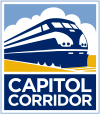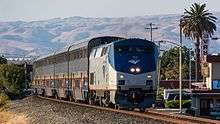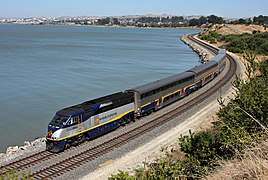Capitol Corridor
 | ||||||||||||||||||||||||||||||||||||||||||||||||||||||||||||||||||||||||||||||||||||||||||||||||||||||||||||||||||||||||||||||||||||||||||||||||||||||||||||||||||||||||||||||||||||||||||||||||||||||||||||||||||||||||||||||||||||||||||||||||||||||||||||||||||||||||||||||||||||||||||||||||||||||||||||||||||||||||||||||||||||||||||||||||||||||||||||||||||||||||||||||||||||||||||||||||||||||||||||||||||||||||||||||||||||||||||||||||||||||||||||||||||||||||||||||||||||||||||||||||||||||||||||||||||||||||||||||||||||||||||||||||||||||||||||||||||||||||||||||||||||||||||||||||||||||||||
 A Capitol Corridor train in Rodeo in January 2010 | ||||||||||||||||||||||||||||||||||||||||||||||||||||||||||||||||||||||||||||||||||||||||||||||||||||||||||||||||||||||||||||||||||||||||||||||||||||||||||||||||||||||||||||||||||||||||||||||||||||||||||||||||||||||||||||||||||||||||||||||||||||||||||||||||||||||||||||||||||||||||||||||||||||||||||||||||||||||||||||||||||||||||||||||||||||||||||||||||||||||||||||||||||||||||||||||||||||||||||||||||||||||||||||||||||||||||||||||||||||||||||||||||||||||||||||||||||||||||||||||||||||||||||||||||||||||||||||||||||||||||||||||||||||||||||||||||||||||||||||||||||||||||||||||||||||||||||
| Overview | ||||||||||||||||||||||||||||||||||||||||||||||||||||||||||||||||||||||||||||||||||||||||||||||||||||||||||||||||||||||||||||||||||||||||||||||||||||||||||||||||||||||||||||||||||||||||||||||||||||||||||||||||||||||||||||||||||||||||||||||||||||||||||||||||||||||||||||||||||||||||||||||||||||||||||||||||||||||||||||||||||||||||||||||||||||||||||||||||||||||||||||||||||||||||||||||||||||||||||||||||||||||||||||||||||||||||||||||||||||||||||||||||||||||||||||||||||||||||||||||||||||||||||||||||||||||||||||||||||||||||||||||||||||||||||||||||||||||||||||||||||||||||||||||||||||||||||
|---|---|---|---|---|---|---|---|---|---|---|---|---|---|---|---|---|---|---|---|---|---|---|---|---|---|---|---|---|---|---|---|---|---|---|---|---|---|---|---|---|---|---|---|---|---|---|---|---|---|---|---|---|---|---|---|---|---|---|---|---|---|---|---|---|---|---|---|---|---|---|---|---|---|---|---|---|---|---|---|---|---|---|---|---|---|---|---|---|---|---|---|---|---|---|---|---|---|---|---|---|---|---|---|---|---|---|---|---|---|---|---|---|---|---|---|---|---|---|---|---|---|---|---|---|---|---|---|---|---|---|---|---|---|---|---|---|---|---|---|---|---|---|---|---|---|---|---|---|---|---|---|---|---|---|---|---|---|---|---|---|---|---|---|---|---|---|---|---|---|---|---|---|---|---|---|---|---|---|---|---|---|---|---|---|---|---|---|---|---|---|---|---|---|---|---|---|---|---|---|---|---|---|---|---|---|---|---|---|---|---|---|---|---|---|---|---|---|---|---|---|---|---|---|---|---|---|---|---|---|---|---|---|---|---|---|---|---|---|---|---|---|---|---|---|---|---|---|---|---|---|---|---|---|---|---|---|---|---|---|---|---|---|---|---|---|---|---|---|---|---|---|---|---|---|---|---|---|---|---|---|---|---|---|---|---|---|---|---|---|---|---|---|---|---|---|---|---|---|---|---|---|---|---|---|---|---|---|---|---|---|---|---|---|---|---|---|---|---|---|---|---|---|---|---|---|---|---|---|---|---|---|---|---|---|---|---|---|---|---|---|---|---|---|---|---|---|---|---|---|---|---|---|---|---|---|---|---|---|---|---|---|---|---|---|---|---|---|---|---|---|---|---|---|---|---|---|---|---|---|---|---|---|---|---|---|---|---|---|---|---|---|---|---|---|---|---|---|---|---|---|---|---|---|---|---|---|---|---|---|---|---|---|---|---|---|---|---|---|---|---|---|---|---|---|---|---|---|---|---|---|---|---|---|---|---|---|---|---|---|---|---|---|---|---|---|---|---|---|---|---|---|---|---|---|---|---|---|---|---|---|---|---|---|---|---|---|---|---|---|---|---|---|---|---|---|---|---|---|---|---|---|---|---|---|---|---|---|---|---|---|---|---|---|---|---|---|---|---|---|---|---|---|---|---|---|---|---|---|---|---|---|---|---|---|---|---|---|---|---|---|---|---|---|---|---|---|---|---|---|---|---|---|---|---|---|---|---|---|---|---|---|---|---|---|---|---|---|---|---|---|---|---|---|---|---|---|---|---|---|---|---|---|---|---|---|---|---|---|---|---|---|---|---|---|---|---|---|---|---|---|---|---|---|---|---|---|
| Service type | Inter-city rail/Commuter rail | |||||||||||||||||||||||||||||||||||||||||||||||||||||||||||||||||||||||||||||||||||||||||||||||||||||||||||||||||||||||||||||||||||||||||||||||||||||||||||||||||||||||||||||||||||||||||||||||||||||||||||||||||||||||||||||||||||||||||||||||||||||||||||||||||||||||||||||||||||||||||||||||||||||||||||||||||||||||||||||||||||||||||||||||||||||||||||||||||||||||||||||||||||||||||||||||||||||||||||||||||||||||||||||||||||||||||||||||||||||||||||||||||||||||||||||||||||||||||||||||||||||||||||||||||||||||||||||||||||||||||||||||||||||||||||||||||||||||||||||||||||||||||||||||||||||||||
| Locale | Northern California | |||||||||||||||||||||||||||||||||||||||||||||||||||||||||||||||||||||||||||||||||||||||||||||||||||||||||||||||||||||||||||||||||||||||||||||||||||||||||||||||||||||||||||||||||||||||||||||||||||||||||||||||||||||||||||||||||||||||||||||||||||||||||||||||||||||||||||||||||||||||||||||||||||||||||||||||||||||||||||||||||||||||||||||||||||||||||||||||||||||||||||||||||||||||||||||||||||||||||||||||||||||||||||||||||||||||||||||||||||||||||||||||||||||||||||||||||||||||||||||||||||||||||||||||||||||||||||||||||||||||||||||||||||||||||||||||||||||||||||||||||||||||||||||||||||||||||
| First service | December 12, 1991 | |||||||||||||||||||||||||||||||||||||||||||||||||||||||||||||||||||||||||||||||||||||||||||||||||||||||||||||||||||||||||||||||||||||||||||||||||||||||||||||||||||||||||||||||||||||||||||||||||||||||||||||||||||||||||||||||||||||||||||||||||||||||||||||||||||||||||||||||||||||||||||||||||||||||||||||||||||||||||||||||||||||||||||||||||||||||||||||||||||||||||||||||||||||||||||||||||||||||||||||||||||||||||||||||||||||||||||||||||||||||||||||||||||||||||||||||||||||||||||||||||||||||||||||||||||||||||||||||||||||||||||||||||||||||||||||||||||||||||||||||||||||||||||||||||||||||||
| Current operator(s) | Capitol Corridor Joint Powers Authority, in partnership with Amtrak and Caltrans | |||||||||||||||||||||||||||||||||||||||||||||||||||||||||||||||||||||||||||||||||||||||||||||||||||||||||||||||||||||||||||||||||||||||||||||||||||||||||||||||||||||||||||||||||||||||||||||||||||||||||||||||||||||||||||||||||||||||||||||||||||||||||||||||||||||||||||||||||||||||||||||||||||||||||||||||||||||||||||||||||||||||||||||||||||||||||||||||||||||||||||||||||||||||||||||||||||||||||||||||||||||||||||||||||||||||||||||||||||||||||||||||||||||||||||||||||||||||||||||||||||||||||||||||||||||||||||||||||||||||||||||||||||||||||||||||||||||||||||||||||||||||||||||||||||||||||
| Annual ridership | 1,607,277 (FY17)[1] | |||||||||||||||||||||||||||||||||||||||||||||||||||||||||||||||||||||||||||||||||||||||||||||||||||||||||||||||||||||||||||||||||||||||||||||||||||||||||||||||||||||||||||||||||||||||||||||||||||||||||||||||||||||||||||||||||||||||||||||||||||||||||||||||||||||||||||||||||||||||||||||||||||||||||||||||||||||||||||||||||||||||||||||||||||||||||||||||||||||||||||||||||||||||||||||||||||||||||||||||||||||||||||||||||||||||||||||||||||||||||||||||||||||||||||||||||||||||||||||||||||||||||||||||||||||||||||||||||||||||||||||||||||||||||||||||||||||||||||||||||||||||||||||||||||||||||
| Website | Capitol Corridor | |||||||||||||||||||||||||||||||||||||||||||||||||||||||||||||||||||||||||||||||||||||||||||||||||||||||||||||||||||||||||||||||||||||||||||||||||||||||||||||||||||||||||||||||||||||||||||||||||||||||||||||||||||||||||||||||||||||||||||||||||||||||||||||||||||||||||||||||||||||||||||||||||||||||||||||||||||||||||||||||||||||||||||||||||||||||||||||||||||||||||||||||||||||||||||||||||||||||||||||||||||||||||||||||||||||||||||||||||||||||||||||||||||||||||||||||||||||||||||||||||||||||||||||||||||||||||||||||||||||||||||||||||||||||||||||||||||||||||||||||||||||||||||||||||||||||||
| Route | ||||||||||||||||||||||||||||||||||||||||||||||||||||||||||||||||||||||||||||||||||||||||||||||||||||||||||||||||||||||||||||||||||||||||||||||||||||||||||||||||||||||||||||||||||||||||||||||||||||||||||||||||||||||||||||||||||||||||||||||||||||||||||||||||||||||||||||||||||||||||||||||||||||||||||||||||||||||||||||||||||||||||||||||||||||||||||||||||||||||||||||||||||||||||||||||||||||||||||||||||||||||||||||||||||||||||||||||||||||||||||||||||||||||||||||||||||||||||||||||||||||||||||||||||||||||||||||||||||||||||||||||||||||||||||||||||||||||||||||||||||||||||||||||||||||||||||
| Start | Auburn, California | |||||||||||||||||||||||||||||||||||||||||||||||||||||||||||||||||||||||||||||||||||||||||||||||||||||||||||||||||||||||||||||||||||||||||||||||||||||||||||||||||||||||||||||||||||||||||||||||||||||||||||||||||||||||||||||||||||||||||||||||||||||||||||||||||||||||||||||||||||||||||||||||||||||||||||||||||||||||||||||||||||||||||||||||||||||||||||||||||||||||||||||||||||||||||||||||||||||||||||||||||||||||||||||||||||||||||||||||||||||||||||||||||||||||||||||||||||||||||||||||||||||||||||||||||||||||||||||||||||||||||||||||||||||||||||||||||||||||||||||||||||||||||||||||||||||||||
| Stops | 17 | |||||||||||||||||||||||||||||||||||||||||||||||||||||||||||||||||||||||||||||||||||||||||||||||||||||||||||||||||||||||||||||||||||||||||||||||||||||||||||||||||||||||||||||||||||||||||||||||||||||||||||||||||||||||||||||||||||||||||||||||||||||||||||||||||||||||||||||||||||||||||||||||||||||||||||||||||||||||||||||||||||||||||||||||||||||||||||||||||||||||||||||||||||||||||||||||||||||||||||||||||||||||||||||||||||||||||||||||||||||||||||||||||||||||||||||||||||||||||||||||||||||||||||||||||||||||||||||||||||||||||||||||||||||||||||||||||||||||||||||||||||||||||||||||||||||||||
| End | San Jose, California | |||||||||||||||||||||||||||||||||||||||||||||||||||||||||||||||||||||||||||||||||||||||||||||||||||||||||||||||||||||||||||||||||||||||||||||||||||||||||||||||||||||||||||||||||||||||||||||||||||||||||||||||||||||||||||||||||||||||||||||||||||||||||||||||||||||||||||||||||||||||||||||||||||||||||||||||||||||||||||||||||||||||||||||||||||||||||||||||||||||||||||||||||||||||||||||||||||||||||||||||||||||||||||||||||||||||||||||||||||||||||||||||||||||||||||||||||||||||||||||||||||||||||||||||||||||||||||||||||||||||||||||||||||||||||||||||||||||||||||||||||||||||||||||||||||||||||
| Distance travelled | 168 miles (270 km) | |||||||||||||||||||||||||||||||||||||||||||||||||||||||||||||||||||||||||||||||||||||||||||||||||||||||||||||||||||||||||||||||||||||||||||||||||||||||||||||||||||||||||||||||||||||||||||||||||||||||||||||||||||||||||||||||||||||||||||||||||||||||||||||||||||||||||||||||||||||||||||||||||||||||||||||||||||||||||||||||||||||||||||||||||||||||||||||||||||||||||||||||||||||||||||||||||||||||||||||||||||||||||||||||||||||||||||||||||||||||||||||||||||||||||||||||||||||||||||||||||||||||||||||||||||||||||||||||||||||||||||||||||||||||||||||||||||||||||||||||||||||||||||||||||||||||||
| Average journey time | 3 hours 15 minutes | |||||||||||||||||||||||||||||||||||||||||||||||||||||||||||||||||||||||||||||||||||||||||||||||||||||||||||||||||||||||||||||||||||||||||||||||||||||||||||||||||||||||||||||||||||||||||||||||||||||||||||||||||||||||||||||||||||||||||||||||||||||||||||||||||||||||||||||||||||||||||||||||||||||||||||||||||||||||||||||||||||||||||||||||||||||||||||||||||||||||||||||||||||||||||||||||||||||||||||||||||||||||||||||||||||||||||||||||||||||||||||||||||||||||||||||||||||||||||||||||||||||||||||||||||||||||||||||||||||||||||||||||||||||||||||||||||||||||||||||||||||||||||||||||||||||||||
| Train number(s) |
Weekdays: 520-553 Weekends: 720-751 | |||||||||||||||||||||||||||||||||||||||||||||||||||||||||||||||||||||||||||||||||||||||||||||||||||||||||||||||||||||||||||||||||||||||||||||||||||||||||||||||||||||||||||||||||||||||||||||||||||||||||||||||||||||||||||||||||||||||||||||||||||||||||||||||||||||||||||||||||||||||||||||||||||||||||||||||||||||||||||||||||||||||||||||||||||||||||||||||||||||||||||||||||||||||||||||||||||||||||||||||||||||||||||||||||||||||||||||||||||||||||||||||||||||||||||||||||||||||||||||||||||||||||||||||||||||||||||||||||||||||||||||||||||||||||||||||||||||||||||||||||||||||||||||||||||||||||
| Technical | ||||||||||||||||||||||||||||||||||||||||||||||||||||||||||||||||||||||||||||||||||||||||||||||||||||||||||||||||||||||||||||||||||||||||||||||||||||||||||||||||||||||||||||||||||||||||||||||||||||||||||||||||||||||||||||||||||||||||||||||||||||||||||||||||||||||||||||||||||||||||||||||||||||||||||||||||||||||||||||||||||||||||||||||||||||||||||||||||||||||||||||||||||||||||||||||||||||||||||||||||||||||||||||||||||||||||||||||||||||||||||||||||||||||||||||||||||||||||||||||||||||||||||||||||||||||||||||||||||||||||||||||||||||||||||||||||||||||||||||||||||||||||||||||||||||||||||
| Track gauge |
4 ft 8 1⁄2 in (1,435 mm) (standard gauge) | |||||||||||||||||||||||||||||||||||||||||||||||||||||||||||||||||||||||||||||||||||||||||||||||||||||||||||||||||||||||||||||||||||||||||||||||||||||||||||||||||||||||||||||||||||||||||||||||||||||||||||||||||||||||||||||||||||||||||||||||||||||||||||||||||||||||||||||||||||||||||||||||||||||||||||||||||||||||||||||||||||||||||||||||||||||||||||||||||||||||||||||||||||||||||||||||||||||||||||||||||||||||||||||||||||||||||||||||||||||||||||||||||||||||||||||||||||||||||||||||||||||||||||||||||||||||||||||||||||||||||||||||||||||||||||||||||||||||||||||||||||||||||||||||||||||||||
| Track owner(s) | UP and JPBX | |||||||||||||||||||||||||||||||||||||||||||||||||||||||||||||||||||||||||||||||||||||||||||||||||||||||||||||||||||||||||||||||||||||||||||||||||||||||||||||||||||||||||||||||||||||||||||||||||||||||||||||||||||||||||||||||||||||||||||||||||||||||||||||||||||||||||||||||||||||||||||||||||||||||||||||||||||||||||||||||||||||||||||||||||||||||||||||||||||||||||||||||||||||||||||||||||||||||||||||||||||||||||||||||||||||||||||||||||||||||||||||||||||||||||||||||||||||||||||||||||||||||||||||||||||||||||||||||||||||||||||||||||||||||||||||||||||||||||||||||||||||||||||||||||||||||||
| ||||||||||||||||||||||||||||||||||||||||||||||||||||||||||||||||||||||||||||||||||||||||||||||||||||||||||||||||||||||||||||||||||||||||||||||||||||||||||||||||||||||||||||||||||||||||||||||||||||||||||||||||||||||||||||||||||||||||||||||||||||||||||||||||||||||||||||||||||||||||||||||||||||||||||||||||||||||||||||||||||||||||||||||||||||||||||||||||||||||||||||||||||||||||||||||||||||||||||||||||||||||||||||||||||||||||||||||||||||||||||||||||||||||||||||||||||||||||||||||||||||||||||||||||||||||||||||||||||||||||||||||||||||||||||||||||||||||||||||||||||||||||||||||||||||||||||
The Capitol Corridor is a 168-mile (270 km) passenger train route operated by Amtrak in California. Capitol Corridor trains operate between San Jose and Sacramento, roughly parallel to Interstate 880 and Interstate 80. One train a day continues through the eastern Sacramento suburbs to Auburn, in the foothills of the Sierra Nevada. Capitol Corridor trains started in 1991.
Like all regional trains in California, the Capitol Corridor is operated by a joint powers authority. The Capitol Corridor Joint Powers Authority (CCJPA) is governed by a board that includes two elected representatives from each of eight counties the train travels through. The CCJPA contracts with the San Francisco Bay Area Rapid Transit District to provide day-to-day management, and Amtrak to operate and maintain the rolling stock (locomotives and passenger cars). The California Department of Transportation (Caltrans) provides the funding and also owns the rolling stock.
History
Former service
The First Transcontinental Railroad was completed to Oakland from the south in 1869. Following the completion of the California Pacific Railroad in 1879, most long-distance service of the Southern Pacific (SP) reached Oakland from the north. Long-distance service from the south ran to San Francisco via the Peninsula; some trains had Oakland sections. The Western Pacific Railroad (completed to Oakland in 1910) and Santa Fe Railroad (completed to Oakland in 1903 over the former California and Nevada Railroad) largely ran long-distance service with limited local stops. Commuter service around Oakland was largely provided by the electric interurban trains of the SP-owned East Bay Electric Lines (1911-1941) and Key System (1901-1958).
By the end of the 1930s, the SP operated five daily local round trips plus a number of long-distance trains between Oakland and Sacramento. The Oakland Lark and an unnamed local train (an Oakland connection for the Coast Daylight) provided local service between Oakland and San Jose on the Coast Line. The inland Niles Subdivision was served by a daily Oakland-Tracy local and a commute-timed Oakland-San Jose local (which ran via Centerville and part of the Coast Line on the northbound trip and Milpitas southbound).[2]
The Oakland-San Jose trip on the Niles Subdivision was discontinued on September 29, 1940, followed by the Oakland-Tracy trip in 1941.[3]:37,40 The two Oakland-San Jose trips on the Coast Line were discontinued on May 1, 1960.[3]:7 The last local service between Oakland and Sacramento was the Senator, discontinued by the SP on May 31, 1962 (though long-distance service continued).[4]:140
Capitols

At the start of the 1990s, three Amtrak intercity trains operated in the Bay Area: the long-distance California Zephyr (Oakland/Emeryville–Chicago) and Coast Starlight (Los Angeles–Seattle), and the regional San Joaquin (Bakersfield-Oakland). Of the three lines, only the Coast Starlight ran between San Jose and Sacramento—once a day and at inconvenient times. In 1990, California voters passed two ballot propositions providing $105 million to expand service along the route. The new service, named Capitols, debuted on December 12, 1991 with three daily round-trips between San Jose and Sacramento. Of these, a single round-trip continued to Roseville, an eastern Sacramento suburb.[5]
One of the ballot propositions, Proposition 116, provided the name Capitol Corridor—so named because it links the location of California's first state capitol, San Jose, with the current location, Sacramento.[3]:7 The service was known as the Capitols until 2001, when Amtrak began using Capitol Corridor on timetables.[6][7]
Service changes
The Capitols originally ran via the Coast Line from Elmhurst to Santa Clara, with no stops between Oakland and San Jose. In 1992, after the completion of track and signal work, the Capitols were rerouted onto the Niles Subdivision further inland between Elmhurst and Newark. The new route allowed the addition of infill stations at Fremont in 1993 and Hayward in 1997.[3]:33 The Oakland Central station, which had been damaged by the 1989 Loma Prieta earthquake, was closed in 1994, and replaced by new stations at Emeryville in 1993 and Oakland – Jack London Square in 1995.[3]:33 Additional infill stations were added at Santa Clara – Great America in 1993, Oakland Coliseum (with a close connection to BART) in 2005, the existing Caltrain station in Santa Clara in 2012, and at Fairfield-Vacaville in 2017.[8]
One daily round trip was extended east to Colfax via Rocklin and Auburn on January 26, 1998. The trip was cut back to Auburn (with the Rocklin stop retained) on February 27, 2000.[3]:73
Proposed expansion
New stations
Additional stations have been proposed along the route at Hercules, Benicia, and Dixon. Additionally, an intermodal station is planned at the Union City station, connecting to BART as part of a larger Dumbarton Rail Corridor project to connect Union City, Fremont, and Newark to various Peninsula cities via the Dumbarton Rail Bridge.[9] The station is being planned and paid for by BART and the city of Union City.[10]
Vision Plan
The Capitol Corridor Vision Implementation Plan is a long range outline of possible improvements to the service; several realignments along existing and new right-of-ways were considered and studied. Near term suggested improvements include double tracking between San Jose and a realignment to the Coast Subdivision and a new station at the Ardenwood Park-and-Ride followed by track improvements between Emeryville and Richmond. Later goals include tunneling under Jack London Square to eliminate the street-running section there, rerouting freight traffic over another right-of-way between Sacramento and Martinez, and eventual electrification of the line.[11]
Extensions
Two daily Capitol Corridor round trips, along with some Caltrain service, are planned to be extended to Salinas station in 2020.[12] Initial service will have intermediate stops at existing Caltrain stations at Tamien, Morgan Hill, and Gilroy; future phases will add new stations at Castroville and Watsonville/Pajaro.[13]
Preliminary work has started to add second pair of tracks between Oakland and San Jose, which would enable most trains to run from Sacramento to San Jose. A third track between Sacramento and Roseville is planned, which would allow an increase from one round trip per day to 10.[14]
Frequency and ridership

During fiscal year 2017 the Capitol Corridor service carried 1,607,277 passengers, a 2.9% increase over FY2016.[1] Revenue in FY2017 was $33,970,000, a 5.3% increase over FY2016, with a 57% farebox recovery ratio.[1] It is the fourth busiest Amtrak route by ridership, surpassed only by the Northeast Regional, Acela Express, and Pacific Surfliner. As of 2017, Sacramento is the busiest station on the route and the seventh busiest in the Amtrak system.[15]
The Capitol Corridor is used by commuters between the Sacramento area and the Bay Area as an alternative to driving on congested Interstate 80. Monthly passes and discounted trip tickets are available. Many politicians, lobbyists, and aides live in the Bay Area and commute to their jobs in Sacramento, while workers in the Oakland, San Francisco, and Silicon Valley employment centers take the Capitol Corridor trains from their less expensive homes in Solano County and the Sacramento metropolitan area.[16]
Starting on August 28, 2006 the Capitol Corridor had 16 weekday trains each way between Oakland and Sacramento, up from twelve in 2005 and three in 1992. (Seven of the sixteen ran to/from San Jose.) According to its management, ridership on the Capitol Corridor trains tripled between 1998 and 2005.[17] On August 13, 2012, the Capitol Corridor dropped from 16 to 15 weekday round trips between Oakland and Sacramento; one round trip was discontinued due to high fuel costs, low ridership, and a new ability to store an extra train overnight in a Sacramento railyard.[18]
As of February 2013 no weekday trains run the full length of the line between Auburn and San Jose. The single departure from Auburn runs to Oakland Coliseum; of the 14 westward departures from Sacramento seven run to San Jose, three to Coliseum and four to Oakland Jack London Square. Seven trains run San Jose to Sacramento, six downtown Oakland to Sacramento, one Coliseum to Sacramento and one Oakland to Auburn.
Stations and connections
Governance

The Capitol Corridor is fully funded by the state through Caltrans Division of Rail and Mass Transportation (DRMT). Caltrans managed the line from its inception in 1991 to 1997, but in 1998 the administration of the route was transferred to Capitol Corridor Joint Powers Authority (CCJPA), formed by transit agencies of which the Capitol Corridor serves in order to have more local control, while still funded by Caltrans. CCJPA in turn contracted with BART for day-to-day management and staff support; also, CCJPA makes decisions on the service level of Capitol Corridor, capital improvements along the route, and passenger amenities aboard the trains.[19]
The Capitol Corridor Joint Powers Authority is governed by a Board of Directors which consists of 16 representatives from its member agencies:
- Placer County Transportation Planning Agency (PCTPA)
- Solano Transportation Authority (STA)
- Yolo County Transportation District (YCTD)
- Sacramento Regional Transit District (Sac RT)
- San Francisco Bay Area Rapid Transit District (BART)
- Santa Clara Valley Transportation Authority (VTA)
Equipment

| September 2, 2018 | |
|---|---|
| Location | Martinez, California |
| Train | Amtrak #733 |
| |
The Capitol Corridor and its administration agency, the CCJPA, are responsible for the maintenance of the Amtrak California's Northern California fleet, which is used by both the Capitol Corridor and the San Joaquin routes.
When the Capitol Corridor debuted in 1991, it used Amtrak F40PH locomotives and Amtrak Horizon Fleet cars. Dash 8 locomotives were also used as they were brand new at the time. This equipment was used until the mid-1990s when most of the current state-purchased equipment arrived.
The current Northern California fleet includes fifteen EMD F59PHI locomotives (numbered 2001 through 2015), two GE P32-8WH (Dash 8) locomotives (numbered 2051 & 2052, formerly Amtrak 501 & 502), six Siemens Charger locomotives (numbered 2101 through 2106) and a large number of bi-level coaches and café cars which are known as "California Cars". All cars are named after mountains and rivers of California. There are two series of California Cars, the 8000 series and the newer 6000 series. Standard Amtrak equipment such as the GE P42DC, Amtrak's main locomotive, standard Amtrak Dash 8 locomotives, and Superliner cars can appear on Capitol Corridor trains as substitutes.
In rarer cases, F59PHIs from the Amtrak Surfliner and Cascades trains are used. Before 2012, Caltrain EMD F40PH and MPI MP36PH-3C locomotives have been used as substitutes engines, and entire Caltrain trainsets have also been seen during busy periods, such as the peak Thanksgiving holiday weekend.
See also
- Train Life, a 2006 documentary films about passengers on the Capitol Corridor
References
- 1 2 3 "Performance Report 2017" (PDF). Capitol Corridor Joint Powers Authority.
- ↑ "Time Table for the Western Division #229 To Take Effect Tuesday, August 1, 1939 at 12:01 A. M." (PDF). Southern Pacific Railroad. August 1, 1939.
- 1 2 3 4 5 6 Vurek, Matthew Gerald (2016). Images of Modern America: California’s Capitol Corridor. Arcadia Publishing. ISBN 9781467124171.
- ↑ Solomon, Brian (2005). Southern Pacific Passenger Trains. Voyageur Press.
- ↑ "Train links Sacramento, Bay Area". Lodi News-Sentinel. December 12, 1991 – via Google News.
- ↑ Amtrak National Timetable: Spring-Summer 2001. Amtrak. April 29, 2001. p. 62 – via Museum of Railway Timetables.
- ↑ National Timetable: Winter 2000 - Spring 2001. Amtrak. October 29, 2000. p. 62 – via Museum of Railway Timetables.
- ↑ "Coming Monday, November 13: New Schedule and Opening of Fairfield-Vacaville Station" (Press release). Capitol Corridor Joint Powers Authority. November 2, 2017.
- ↑ "Summary of the Dumbarton Rail Corridor Project Study Report" (PDF). San Mateo County Transit Authority. May 2004. pp. 3, 18. Archived (PDF) from the original on 18 March 2016. Retrieved 18 March 2016.
- ↑ SamTrans - Dumbarton Rail Corridor
- ↑ "CAPITOL CORRIDOR VISION IMPLEMENTATION PLAN" (PDF). Capitol Corridor. Capitol Corridor Joint Powers Authority. Retrieved 21 June 2017.
- ↑ Rahaim, Nick (January 5, 2017). "Frank's Fish Market will close to pave way for new Salinas train station". Monterey County Weekly.
- ↑ "TAMC Selects LAN as Part of Construction Management Team for Salinas Rail Extension". Mass Transit. 3 January 2018. Retrieved 2 February 2018.
- ↑ "Sac-Roseville Third Track". Capitol Corridor Joint Powers Authority.
- ↑ "State of California FY2017 Fact Sheet" (PDF). Amtrak. November 2017. Retrieved June 6, 2018.
- ↑ Cabanatuan, Michael (December 26, 2000). "Capitol Corridor Ridership Grows On Stretching Bay Area Commutes". San Francisco Chronicle.
- ↑ Capitol Corridor's Largest Service Increase Ever Brings More Direct Trains To Sacramento Archived October 13, 2006, at the Wayback Machine.
- ↑ "Capitol Corridor to Adjust Service Between Oakland and Sacramento". Capitol Corridor Joint Powers Authority. August 7, 2012.
Effective Monday, August 13, 2012, for the first time in 20 years of service the Capitol Corridor Joint Powers Authority (CCJPA) will reduce the number of weekday trains it operates. On August 13 the CCJPA will discontinue Trains 518 and 553.
- ↑ Sheehan, Tim (June 26, 2015). "Valley agency takes control of Amtrak San Joaquin trains". Fresno Bee. Retrieved 11 February 2016.
External links
| Wikimedia Commons has media related to Capitol Corridor. |
Route map: